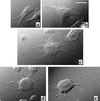Pearling in cells: a clue to understanding cell shape
- PMID: 10468576
- PMCID: PMC17856
- DOI: 10.1073/pnas.96.18.10140
Pearling in cells: a clue to understanding cell shape
Abstract
Gradual disruption of the actin cytoskeleton induces a series of structural shape changes in cells leading to a transformation of cylindrical cell extensions into a periodic chain of "pearls." Quantitative measurements of the pearling instability give a square-root behavior for the wavelength as a function of drug concentration. We present a theory that explains these observations in terms of the interplay between rigidity of the submembranous actin shell and tension that is induced by boundary conditions set by adhesion points. The theory allows estimation of the rigidity and thickness of this supporting shell. The same theoretical considerations explain the shape of nonadherent edges in the general case of untreated cells.
Figures




References
-
- Janmey P A. Curr Opin Cell Biol. 1991;3:4–11. - PubMed
-
- Wang N, Butler J P, Ingber D E. Science. 1993;260:1124–1127. - PubMed
-
- Chicurel M E, Chen C S, Ingber D E. Curr Opin Cell Biol. 1998;10:232–239. - PubMed
-
- Sackmann E. FEBS Lett. 1994;346:3–16. - PubMed
-
- Coue M, Brenner S L, Spector I, Korn E D. FEBS Lett. 1987;213:316–318. - PubMed
Publication types
MeSH terms
Substances
LinkOut - more resources
Full Text Sources

